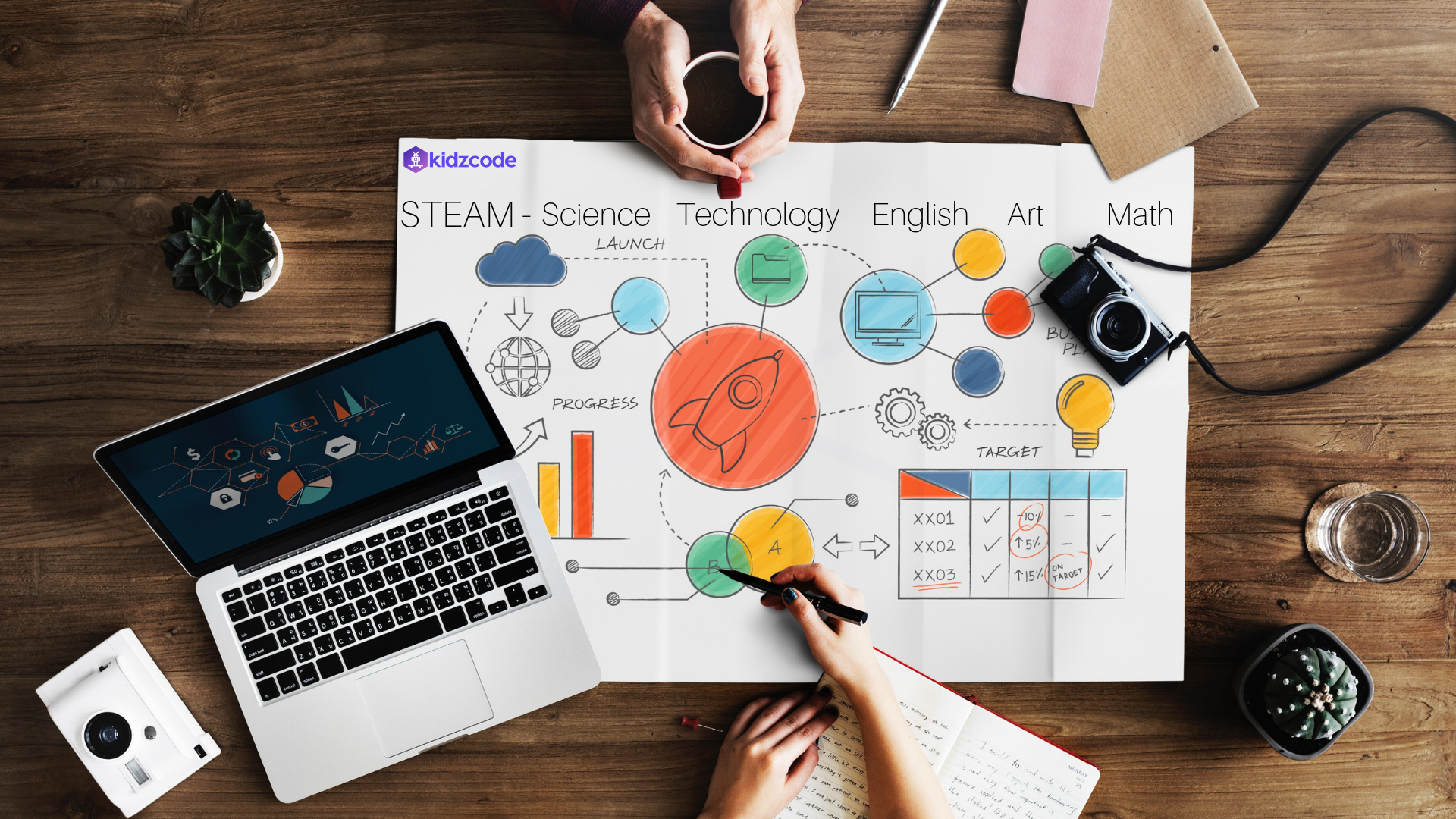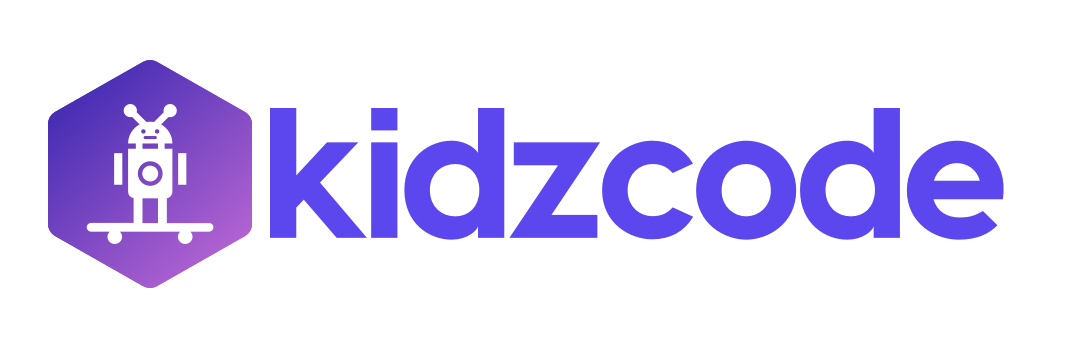
OVERVIEW
Our society is driven by math, science and technology and engineering these days. With continuing advances in the technological areas, we need to be able to keep up with the rest of the world and be competitive in these fields. The problem in our country is that we have been behind the rest of the world in our learning of these important subjects. We need engineers to build the new technologies in our society. We need people who know the ins and outs of computers. Science is needed for research and learning to expand the fields. Math is a huge part of coding and engineering as well. I think art plays a huge roll in all of it. We need creative designers to tie all of it together to make it all look beautiful, fresh, and unique! with KidzCode STEAM education.
ENGLISH SYLLABUS OUTLINE PER GRADE
English Language Concepts and Skills
- Sentence structure | Nouns | Pronouns | Verbs
- Adjectives and adverbs | Prepositions | Conjunctions
- Contractions | Punctuation, capitalization and formatting
- Prefixes and suffixes | Greek and Latin roots
- Reference skills | Word relationships and usage
- Author’s purpose and tone | Figurative language
English Language Concepts and Skills
- Sentence structure | Nouns | Pronouns | Verbs
- Adjectives and adverbs | Prepositions | Conjunctions
- Contractions | Punctuation, capitalization and formatting
- Prefixes and suffixes | Greek and Latin roots
- Reference skills | Word relationships and usage
- Common errors | Author’s purpose and tone
- Literary devices – Idioms ,Use personification
English Language Concepts and Skills
- Sentence structure | Nouns | Pronouns | Verbs
- Adjectives and adverbs | Prepositions | Conjunctions
- Contractions | Punctuation, capitalization and formatting
- Prefixes and suffixes | Greek and Latin roots
- Reference skills | Word relationships and usage
- Context clues | Writing clear and concise sentences
- Common errors | Author’s purpose and tone
- Literary devices – source of allusions,figures of speech
English Language Concepts and Skills
- Sentence structure | Nouns | Pronouns | Verbs and verbals
- Adjectives and adverbs | Prepositions | Conjunctions
- Contractions | Punctuation, capitalization and formatting
- Prefixes and suffixes | Greek and Latin roots
- Reference skills | Word relationships and usage
- Context clues | Writing clear and concise sentences
- Common errors | Author’s purpose and tone
- Literary devices – meaning of allusions,figures of speech
English Language Concepts and Skills
- Sentence structure | Nouns | Pronouns | Verbs and verbals
- Adjectives and adverbs | Punctuation, capitalization and formatting
- Prefixes and suffixes | Etymologies and foreign expressions
- Reference skills | Word choice and usage
- Context clues | Research writing
- Writing arguments | Author’s purpose and tone
- Literary devices – meaning of allusions,figures of speech
English Language Concepts and Skills
- Sentence structure | Nouns | Pronouns | Verbs and verbals
- Adjectives and adverbs | Punctuation and Capitalization
- Prefixes and suffixes | Etymologies and foreign expressions
- Reference skills | Word choice and usage
- Context clues | Writing clear and concise sentences
- Common Errors | Research writing
- Writing arguments | Author’s purpose and tone
- Literary devices
English Language Concepts and Skills
- Sentence structure | Pronouns | Verbs and verbals
- Adjectives and adverbs | Punctuation and Capitalization
- Prefixes and suffixes | Etymologies and foreign expressions
- Word choice and usage | Literary devices
- Context clues | Writing clear and concise sentences
- Common Errors | Research writing
- Writing arguments | Author’s purpose and tone
English Language Concepts and Skills
- Sentence structure | Pronouns | Verbs and verbals
- Adjectives and adverbs | Punctuation and Capitalization
- Prefixes and suffixes | Etymologies and foreign expressions
- Word choice and usage | Literary devices
- Context clues | Writing clear and concise sentences
- Common Errors | Research writing
- Writing arguments | Author’s purpose and tone
SCIENCE SYLLABUS OUTLINE PER GRADE
Science Concepts and Skills
- Understanding Life Systems – Human Organ Systems
- Understanding Structures and Mechanisms – Forces Acting on Structures and Mechanisms
- Understanding Matter and Energy – Properties of and Changes in Matter
- Understanding Earth and Space Systems – Conservation of Energy and Resources
Science Concepts and Skills
- Understanding Life Systems – Biodiversity
- Understanding Structures and Mechanisms – Flight
- Understanding Matter and Energy – Electricity and Electrical Devices
- Understanding Earth and Space Systems – Space
Science Concepts and Skills
- Understanding Life Systems – Interactions in the Environment
- Understanding Structures and Mechanisms – Form and Function
- Understanding Matter and Energy – Pure Substances and Mixtures
- Understanding Earth and Space Systems – Heat in the Environment
Science Concepts and Skills
- Understanding Life Systems – Cells
- Understanding Structures and Mechanisms – Systems in Action
- Understanding Matter and Energy – Fluids
- Understanding Earth and Space Systems – Water Systems
Science Concepts and Skills
- Chemistry: Atoms and Elements and Compunds/Exploring Matter
- Earth and Space Science: The Study of the Universe/Space Exploration
- Physics: The Characteristics of Electricity/Electrical Applications
- Biology: Reproduction, Sustainable Ecosystems
Science Concepts and Skills
- Chemistry: Chemical Process and Reactions
- Earth and Space Science: Weather Dynamics and Climate Change
- Physics: Motion and Light and Geometric Optics
- Biology: Ecosystems, Tissues, Organs,and Systems of Living Things
Science Concepts and Skills
- Chemistry: Matter, ChemicalTrends, Chemical Bonding, Reactions and Quantities, Solutions and Solubility
- Earth and Space Science: Human Health/Environment, Sustainable Agriculture and Forestry, Managing waste, Conservation of Energy
- Physics: Kinematics, Forces, Energy and Society, Waves and Sound, Electricity and Magnetism
- Biology: Diversity of Living Things, Evolution, Genetic Processes
Science Concepts and Skills
- Chemistry: Organic Chemistry, Structure and Properties of Matter, Energy Changes and Rates of Reaction, Chemical Systems and Equilibrium, Electrochemistry
- Earth and Space Science: Astronomy, Planetary Science, Earth’s Geological History, Earth Materials, Geological Processes
- Physics: Dynamics, Energy and Momentum, Gravitational, Electric, and Magnetic Fields, Wave Nature of light, Quantum Mechanics and Special Relativity
- Biology: Biochemistry, Metabolic Process, Molecular Genetics, Homeostasis, Population Dynamics
MATH SYLLABUS OUTLINE PER GRADE
Math Concepts and Skills
- Place values and number sense | Add, Subtract, Multiply, Division
- Number theory | Add, Subtract, Multiply and Divide Decimals
- Money | Fractions and mixed numbers
- Fraction equivalence and ordering | Add and subtract & Multiply fractions
- Mixed operations | Problem solving
- Patterns and sequences | Coordinate plane
- Variable expressions | Data and graphs
- Probability and statistics | Time and Geometric measurement
- Units of measurement | Two-dimensional figures
- Symmetry and transformations | Three-dimensional figures
Math Concepts and Skills
- Whole numbers, Decimals & Integers | Add, Subtract, Multiply, Division
- Exponents & Number theory | Fractions and mixed numbers
- Add, subtract and Multiply fractions | Mixed operations & Rational numbers
- Problem solving and estimation | Ratios and rates, Percents
- Units of measurement | Money & Consumer math
- TIme and Coordinate plane | Expressions and properties
- One-variable equations | Two-variable equations
- Two-dimensional figures | Symmetry and transformations
- Three-dimensional figures | Geometric measurement
- Data and graphs | Statistics &Probability
Math Concepts and Skills
- Number theory | Integers, Operations with integers
- Decimals, Operations with decimals | Fractions and mixed numbers
- Add, Subtract, Multiply, Divide fractions | Rational numbers,Exponents and square roots
- Ratios, rates and proportions | Proportional relationships
- Percents, Consumer math | Problem solving and estimation
- Units of measurement | Coordinate plane
- Number sequences | Expressions and properties
- Equations: One-variable, Two-variable| Two-dimensional figures
- Transformations and congruence | Constructions
- Three-dimensional figures | Geometric measurement
- Data and graphs | Statistics & Probability
Math Concepts and Skills
- Number theory | Integers, Operations with integers
- Operations with fractions | Rational numbers and their operations
- Exponents and roots | Scientific notation
- Ratios, rates and proportions | Proportional relationships
- Percents, Consumer math | Problem solving and estimation
- Units of measurement | Coordinate plane
- Two-dimensional figures | Transformations and congruence
- Transformations and similarity | Pythagorean theorem
- Three-dimensional figures | Geometric measurement
- Number sequences | Expressions and properties
- One-variable equations | Linear functions
- Data and graphs | Probability
Math Concepts and Skills
- Numbers | Operations
- Ratios, rates and proportions | Percents
- Geometry – Circles | Coordinate plane
- Properties | Exponents
- Scientific notation | Problem solving
- Number sequences | Variable expressions and equations
- Solve equations | Single-variable inequalities
- Data and graphs | Relations and functions
- Direct variation | Linear functions
- Systems of linear equations | Monomials, Polynomials
- Logic | Probability & Statistics
Math Concepts and Skills
- Numbers | Exponents
- Scientific notation | Radical expressions
- Rational exponents | Coordinate plane
- Solve equations | Single-variable inequalities
- Data and graphs | Relations and functions
- Direct and inverse variation | Linear functions
- Systems of linear equations | Monomials & Polynomials
- Factoring | Quadratic equations
- Parabolas | Functions: linear, quadratic, exponential
- Rational functions and expressions | Circles in the coordinate plane
- Logic | Measurement | Congruent figures
- Two-dimensional, Three-dimensional figures
- Triangles /Right triangles | Similarity
- Trigonometry | Transformations | Probability Statistics
Math Concepts and Skills
- Measurement | Equations | Inequalities
- Functions | Systems of equations
- Systems of inequalities | Factoring
- Quadratic relations | Parabolas
- Polynomials | Radical functions and expressions
- Rational exponents | Rational functions and expressions
- Exponential functions | Angle measures
- Right triangles | Trigonometry
- Two-dimensional, Three-dimensional figures
- Congruent figures | Triangles /Right triangles
- Similarity | Probability
- Logic | Sequences and series
Math Concepts and Skills
- Functions | Families of functions
- Quadratic relations | Polynomials
- Rational functions | Logarithms
- Exponential and logarithmic functions | Radical functions
- Roots and rational exponents | Systems of equations
- Systems of inequalities | Nonlinear inequalities
- Matrices | Trigonometry | Trigonometric functions
- Trigonometric identities | Conic sections
- Complex numbers | Complex plane
- Polar form | Two-dimensional vectors
- Three-dimensional vectors | Sequences and series
- Logic | Statistics | Probability distributions
Contact Us
- 200 Matheson Blvd W, Suite-202, Mississauga, ON L5R 3L7

